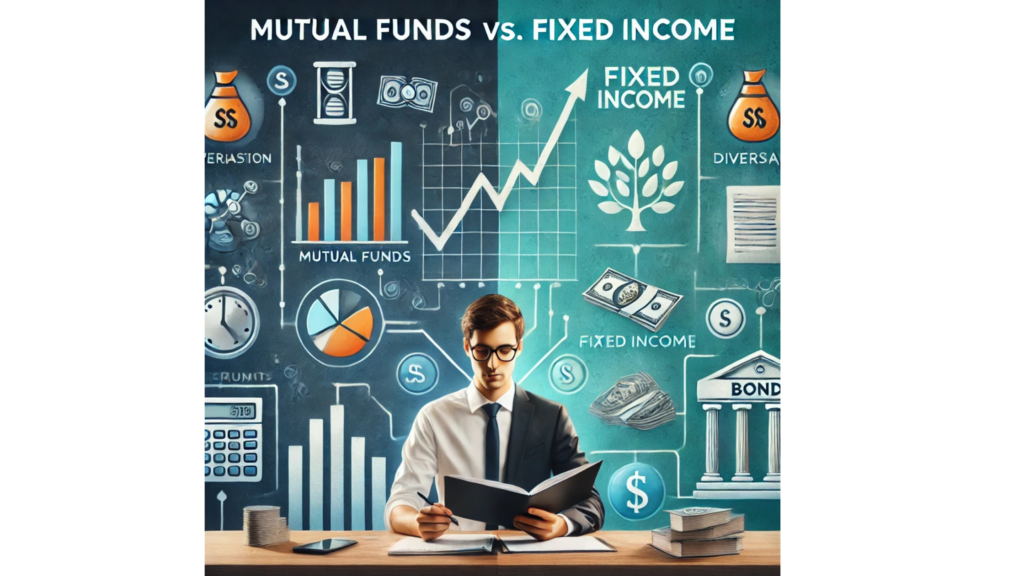Investing is a key pillar of financial growth, offering pathways to build wealth and secure long-term financial stability. Among the many investment choices available, mutual funds and fixed-income products stand out as popular options. Each serves unique purposes and suits different types of investors. Understanding their features, benefits, and risks is essential for making the right financial decisions. Let’s go through a detailed comparison of mutual funds vs fixed income products, helping you navigate these options and tailor them to your financial goals.
What Are Mutual Funds?
The same investment strategy that is common among mutual funds involves combining the capital of many investors to create a diversified portfolio of securities. These can include stocks, bonds, money market instruments, or other assets.
Types Of Mutual Funds
- Equity Funds: These focus on investing in company stocks, aiming for capital appreciation. While they offer the potential for high returns, they also carry higher risks due to market volatility.
- Debt Funds: These funds invest in bonds and other fixed-income securities, providing regular income with lower risk compared to equity funds.
- Hybrid Funds: These combine investments in both equities and fixed-income securities, aiming to balance risk and reward.
- Index Funds: These funds track a specific index, like NIFTY 50 and SENSEX, offering low-cost exposure to a broad market.
- Money Market Funds: This deals with short-term treasuries or fixed-income securities possessing high quality, great liquidity, and less risk, but they offer lower yields.
Advantages Of Mutual Funds
- Diversification: By investing in a wide array of securities, mutual funds spread risk effectively.
- Professional Management: Expert fund managers handle the investments, saving you time and effort.
- Liquidity: Most mutual funds allow you to buy or sell units on any business day, offering flexibility.
- Accessibility: With low minimum investment requirements, mutual funds cater to investors of all levels.
Challenges Of Mutual Funds
- Management Fees: Fund management and administrative fees can eat into returns over time.
- Market Risk: Market fluctuations may affect most mutual funds and those that invest in stock or equity funds.
- Tax Implications: Depending on the type of mutual fund and holding period, returns may be subject to capital gains tax.
What Are Fixed Income Products?
Fixed income products are investments that provide regular interest payments over a specific period, along with the return of principal at maturity. They are considered safer than equities and are often used to preserve capital or generate steady income.
Types Of Fixed Income Products
Government Bonds: Issued by national governments, these are low-risk investments with guaranteed returns.
Corporate Bonds: These are issued by companies and generally offer higher returns than government bonds but with increased risk.
Municipal Bonds: Issued by state or local governments, these often come with tax advantages, making them attractive to certain investors.
Certificates of Deposit (CDs): Offered by banks, CDs come with fixed interest rates and specified maturity periods. They’re low-risk and often insured.
Treasury Bills and Notes: Issued by governments, these short-term and medium-term securities provide a reliable income stream.

Advantages Of Fixed Income Products
Predictable Returns: Fixed interest payments provide consistent income.
Capital Preservation: These products are less volatile than equities, making them ideal for risk-averse investors.
Diversification: Adding fixed-income products will reduce the general risk of the overall portfolio.
Challenges Of Fixed Income Products
Interest Rate Risk: In national economies, there is usually an upward interest direction in household returns; e.g., whereby a call and put option type are employed. This would imply that the value of the bond will decline when the interest rates increase.
Inflation risk: The return on fixed-income investments may become less valuable over time due to inflation.
Credit Risk: There is a chance that the issuer could default, particularly in lower-rated bonds.
Mutual Funds vs. Fixed Income Products: Key Differences
When choosing between mutual funds and fixed-income products, consider the following:
Risk and Return: Mutual funds, particularly equity funds, offer the potential for higher returns but come with greater risk. Fixed-income products provide stability and predictable returns but usually yield lower growth.
Investment Horizon: Mutual funds are suitable for long-term goals like retirement or wealth accumulation. Fixed-income products work well for short- to medium-term needs, such as funding education or saving for a major purchase.
Liquidity: Mutual funds generally offer higher liquidity compared to certain fixed-income products, which may have lock-in periods.
Tax Efficiency: Some fixed-income products, like municipal bonds, offer tax advantages. Certain mutual funds, such as Equity-Linked Savings Schemes (ELSS), also provide tax benefits under specific conditions.
Diversification: Mutual funds inherently diversify your investment by pooling capital into a variety of securities. Fixed-income investments, unless held in a broad portfolio, may lack such diversification.
Blending Mutual Funds And Fixed Income Products
For most investors, a balanced approach combining mutual funds and fixed-income products can offer the best of both worlds. Such a strategy might look like:
Young Investors: Allocate a larger portion to equity mutual funds for growth and a smaller portion to fixed-income products for stability.
Mid-Career Professionals: Diversify between equity and hybrid funds while increasing exposure to fixed-income products to balance risk and reward.
Retirees: Focus on capital preservation by prioritizing fixed-income products and income-generating mutual funds.
Building Your Investment Strategy
Creating a sound investment strategy involves:
Assessing Your Risk Tolerance: Understand your comfort level with risk to determine the right mix of investments.
Setting Financial Goals: Define your short-term, medium-term, and long-term objectives to align investments with your needs.
Monitoring and Rebalancing: You should review your portfolio for your goals and risk profile regularly. When necessary, rebalance your investments to achieve the target asset distribution.
Seeking Expert Guidance: Consider consulting a financial advisor to make informed decisions tailored to your unique financial situation.
The Role Of Professional Advice
Investing can be complex, especially when balancing different asset classes. Professional advisors bring valuable expertise, helping you create a portfolio that aligns with your risk tolerance and financial goals. Financial advisors in Chennai like Intelli360 Wealth provide innovative tools and expert insights, making investment planning easier and more effective.
For those looking to simplify their investment journey, Intelli360 is an excellent resource. It offers tools and personalized advice to help you evaluate options like mutual funds and fixed-income products, ensuring your financial strategy is aligned with your goals. With Intelli360, you gain the confidence to navigate investment choices and achieve lasting financial success.
Both mutual funds and fixed-income products play important roles in a well-rounded investment portfolio. Understanding their differences and benefits can help you make informed decisions tailored to your needs. Partnering with platforms like Intelli360 can further enhance your investment experience, providing the guidance and resources needed to succeed.
While mutual funds offer growth potential and diversification, fixed-income products provide stability and predictable returns. By blending these investment options strategically, you can achieve a balanced portfolio that meets both your short-term and long-term financial goals.

